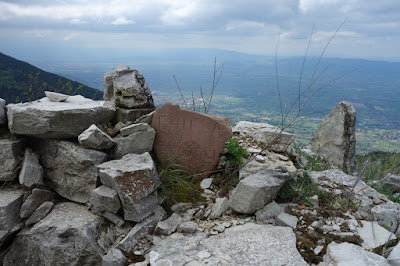Recently I did some exploring along the far side of Monte Subasio in the direction of Spello, starting out along country roads above a thin fog covering the valley.
Within a couple of hours I was deep in the woods, looking to revisit Gabbiano Vecchio. This ghost town has a tiny dilapidated church dedicated to Saint Anthony, home of some beautiful but rapidly deteriorating 17th Century frescos. The unmarked trail into town no longer amounts to much.
Nor does the town itself, after many years of overgrowth.
But the Chiesa di Sant'Antonio is still standing.
Then came a surprise, more good than bad. For years I've been concerned that a lack of maintenance and security for the church are resulting in the deterioration of Sant'Antonio's frescos. The roof is falling in; the entry door disappeared a couple of years ago. Now, someone has taken steps to secure the church with a metal plate.
A good first step. No signs of any repairs, but at least someone has taken notice. Of course, this encouraging finding also meant a trace of disappointment at not getting to view the frescos again. Here's a photo from a 2015 visit.
From Gabbiano Vecchio it was back into the woods in the direction of Monte Pietrolungo, a smaller mountain located in the Spello - Collepino region. I had seen Monte Pietrolungo on maps and had hiked past it on many occasions, but had never seen signposts for a summit trail.
Crossing through the forest, I came across a sign… of peace. Even lesser known paths here can have their Franciscan graffiti.
At one point, my map indicated a lago, or lake. Here it was, humble in size but resting in a tranquil morning setting.
Reaching the road that traverses Mount Subasio, I started downhill, searching for a dirt way that the map indicated went up Monte Pietrolungo. The only realistic option seemed to be this unmarked (other than a sign restricting vehicle access) path, plenty wide with a gentle slope.
I had heard that there was a cross atop Monte Pietrolungo, but wasn't prepared for what would come into view after a comfortable uphill climb.
Though the day was a bit hazy, the views of the Apennines, the valley and towns all the way to Perugia were terrific. Of course, the cross was impressive, as well.
It was time to head back to Assisi. I decided on a different route that involved climbing part way up Subasio and crossing over past Fonte Bregno. On this higher trail it was possible to look back over Monte Pietrolungo. If you have a large enough monitor and look closely, the cross can be seen to the right of center.
From that point it was a long but pleasant stroll back to Assisi, with no shortage of Spring's red poppies along the way.
Ciao.





























